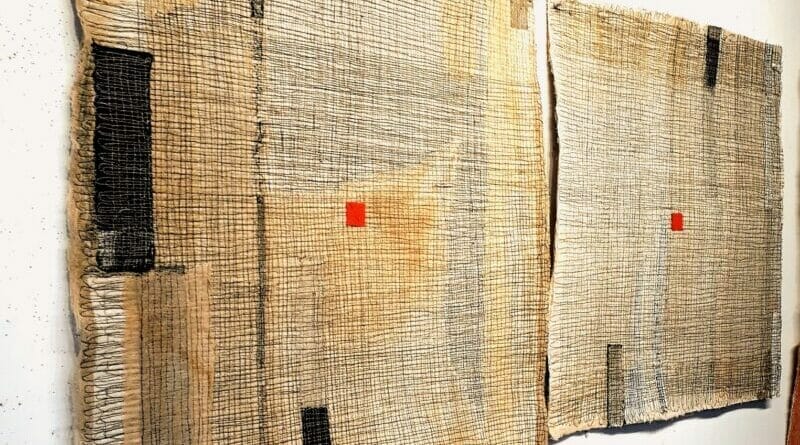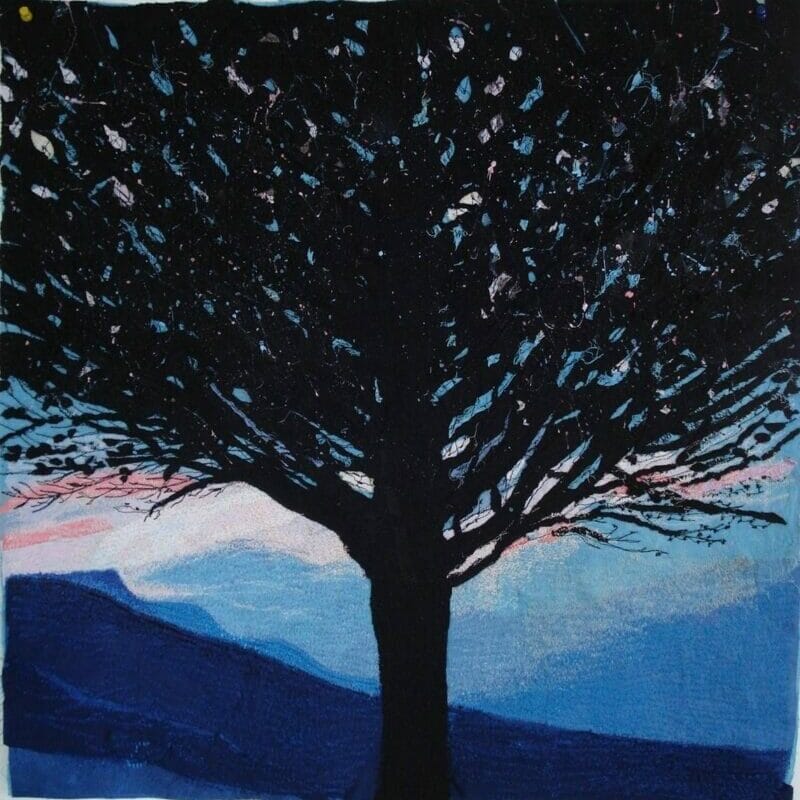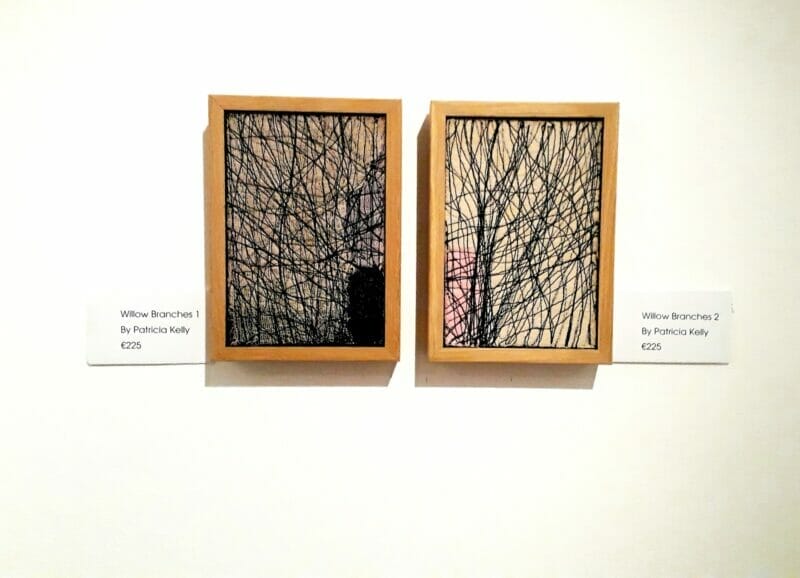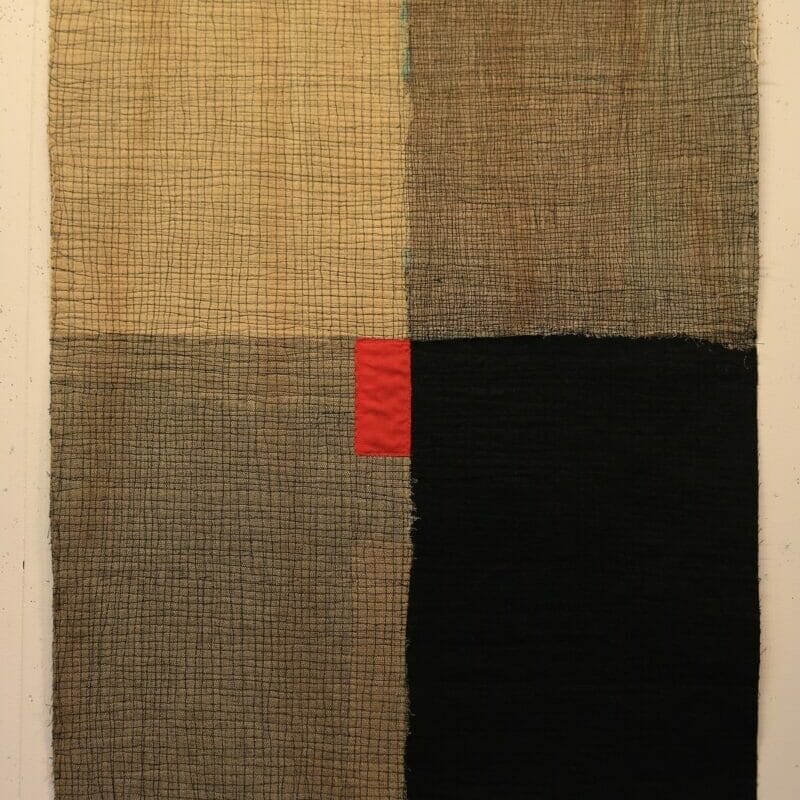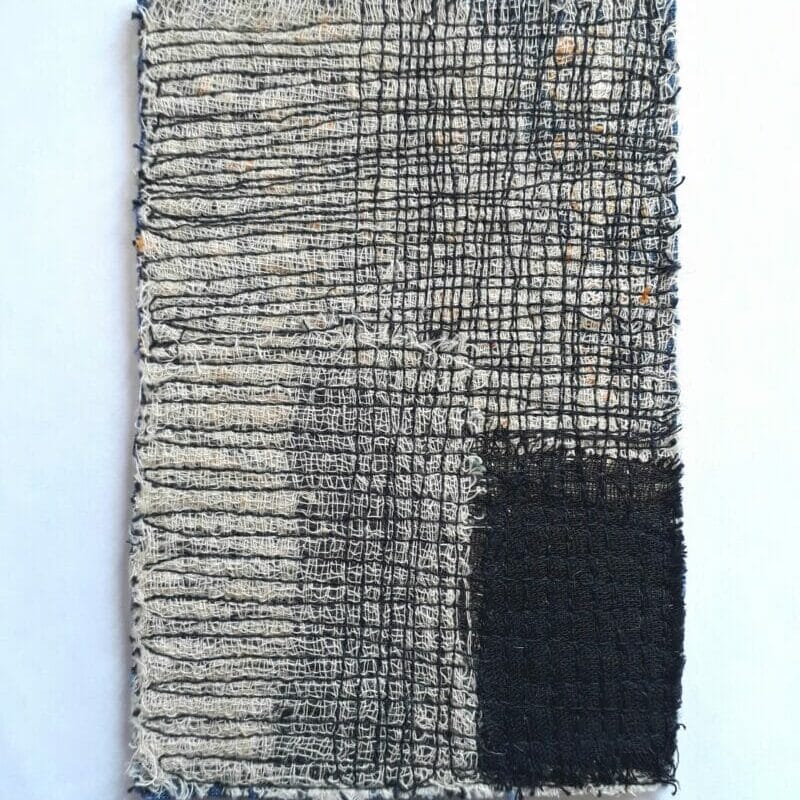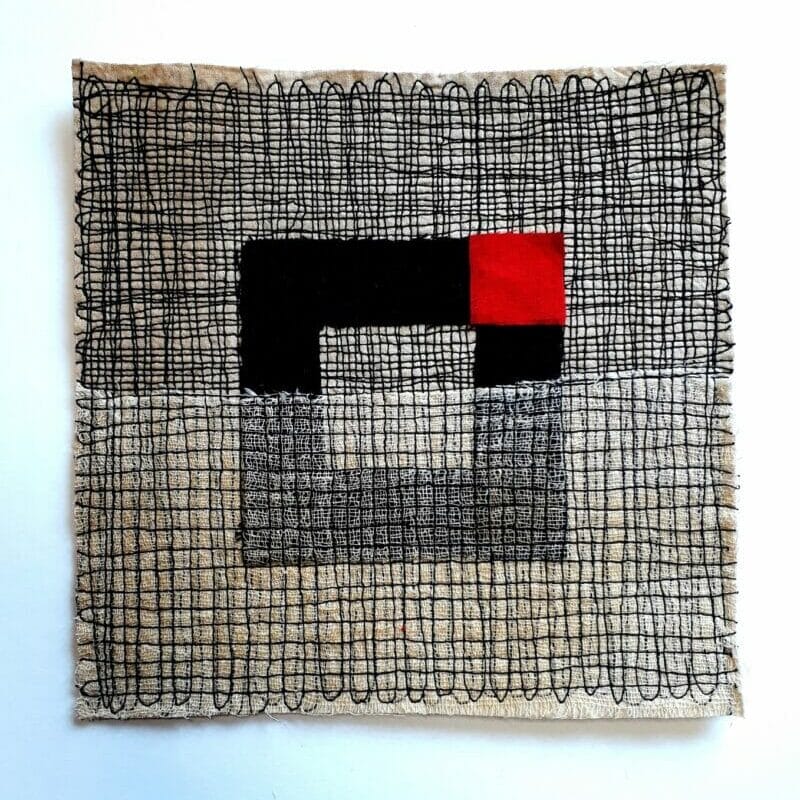PATRICIA KELLY
*Featured photo: Patricia Kelly Machine stitched textile collage 65cm sq
Patricia Kelly is an Irish artist born in County Fermanagh where she lives and works. She attended Ulster University in Belfast where she obtained a B.A. Honours Degree in Fine Craft Design specialising in embroidered textiles in 1986 and later obtained a PGCE in Art Education. She was a lecturer in Art and Design until 2021.
Using free embroidery techniques, she creates works in which the stitched line becomes the form of an artistic expression that is increasingly abstract, influenced and inspired – among other things – by the Japanese concept of wabi-sabi, which is about seeing beauty in imperfection, at least as much as by the rugged landscape and skies of western Ireland, where the lines are created by the hedges that stand out against the coloured skies. The sense of belonging to a place, where family history is intertwined with present lives, is also a defining element of her art, which takes shape through the use of recycled textiles in exactly the same way as the generations before her used to make quilts: a practice that evokes the layering of lives connected and stitched together.
She has exhibited in solo and group shows in public and private spaces in Ireland, USA, Australia, Great Britain. Some of her works are in permanent collections and she has numerous honours and awards to her credit.
Lines, dots, geometric grounds: what is the meaning and message of these signs and shapes? What do your works tell? What themes do you explore through your artistic work?
My work has evolved from the study of my local landscape in the west of Ireland. Looking closer at the landscape, I became preoccupied with the lines of tangled branches silhouetted against the night sky. I realised that my interest was in fine scribbly line. I began to experiment with stitched line only, finding many ways to repeat and overlap line and to through the use transparencies to explore line further. While doing this, I discovered that I was also interested in geometric grounds. I attribute this to our human need to organise spaces. I grew up on a farm where work was both physical and very tactile, making hay and cutting turf. These occupations involved linear processes, cutting in lines, laying organic materials to dry in lines. Fields are ordered with ditches. Not perfectly laid out but in an organic way.
How and why did you start using fibers, threads and textiles for your art work?
I have always been drawn to thread and fibre, from a very young age. I remember the feel of a tweed I used to make a doll’s dress. We practiced a lot of sewing, knitting and craft in primary school. I embroidered my irish dancing dress when I was ten. As I persued Art in school, I always used stitching, collage and batik for my art project outcomes. I went on to art college in Belfast where I completed an Honors degree in Fine craft design, specializing in Embroidery.
What are the techniques and materials you use for your artistic practice and according to which criteria do you choose one or the other for the single work of art?
I allow my ideas to flow and develop. Often something in one piece suggests an idea for the next piece. I used to use a lot of coloured recycled family clothing to create a collaged work overworked with zigzag stitch, while I worked on the more literal landscapes, however now, I am using only straight stitch with mostly black thread on layers of recycled curtain lining, tablecloths, calico and hessian. I use transparencies of scrim to create a pencil drawing effect with the lines of black stitching. I enjoy creating lots of contrast in the work, with some areas more densely worked than others. I sit with pieces to evaluate them as I proceed. The pieces are becoming more geometrically ordered in terms of composition. The line is becoming more fluid.

Do techniques and materials – embroidery for example – also have a conceptual meaning for you as well as a functional one for the realization of the work?
Since I have started to develop the more abstract work, I realise that it has a conceptual meaning. It has brought me back to the abstract work I developed during my degree where I stitched rolled lines of paper creating very linear and strawlike pieces. My work then, was about my past, and is again today, it is about the generations who went before me, who toiled at physically repetitive tasks daily, people who owned little. They were so aware of the natural cycle of the seasons, of nature and of the environment around them. I was lucky to have experienced this life and these activities before machinery took over. I wrote my degree dissertation on the passing of so many traditional craft practices and rural ocupations, such as basket making, haymaking, etc. I live in an ancestral home dating back hundreds of years and I feel an affinity with the previous generations who struggled through very hard times in the past. My great grandfather was a cobbler, the women would have spun wool and embroidered fine lace, but all were involved with the land and with the animals.
How are your works born and how do they develop, from the idea to the finished work of art?
I begin with the burning need to sew, to stitch a continuous line, it is like a therapy, a meditative process. I evaluate the piece as I progress. Sometimes I have an idea of how I want the piece to look but often the piece changes as I progress. It demands a dark area, or looks better turned another way or needs a small element of colour. Often pieces are rejected and these rejected pieces later become material for other works. I love to add previously worked pieces into new works, because like the recycled clothes and materials I use, they already have a history which adds to the final outcome.
How has your art evolved over time?
My work has evolved greatly in recent years. I was made redundant due to rural school closure in June 2021. This has given me the time, I so needed, and yearned for, to devote to my art practice. I have time now, to consider why I am making the work that I do, for example, because elements of red keep appearing in my work, I visited the Irish Museum of Countrylife, to investigate the history of the use of red in our past. I have learned that red was used to dispel evil and that all new borns were wrapped in red cloth. The textile was dyed in the plant Madder, which is believed to have medicinal properties. Women, as well as wearing red skirts and shawls, wrapped their chest in red cloth to protect against rheumatism and lumbago. I believe that black in my work, always a soft fabric, such as a woolen jumper, suggests a safe place, a place of security.
What does being an artist mean to you? And what role, in your opinion, does art have in contemporary society?
Art has always been an essential part of my life. It is a therapy, a quiet place where I can express myself. We all have a something inside, as individual as our signature which needs to find an outlet. The expression of our art practice helps us as individuals to learn so much about ourselves and is critically important to the health of our communities. Art needs to remain high on the priority of politicians and educators if people and communities are to fully develop an understanding of themselves and their place in the world.
